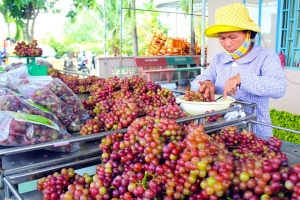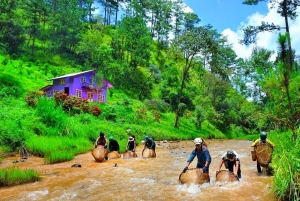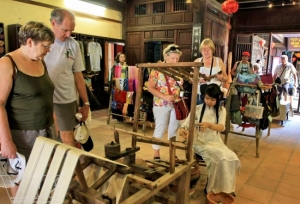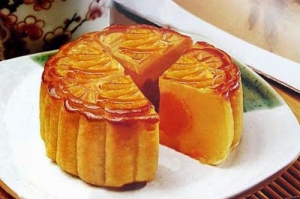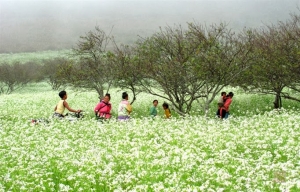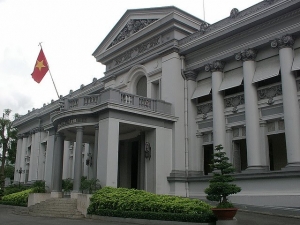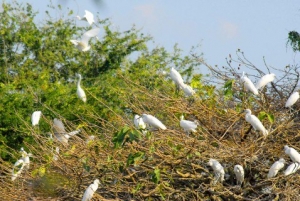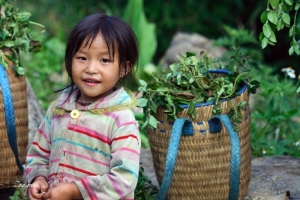
Asia Pacific Travel Team
Visit Uncle Ba Moi's vineyard in Ninh Thuan
The sunlight radiated through the vine leaves creating fanciful emerald patterns and a relaxed atmosphere.
Standing on Mong Bridge spanning the Dinh River, tourists can enjoy the panoramic view of the 2ha vineyard which receives many visitors everyday.
The best time to visit the vineyard is in the summer when the grapes are ripe.
The vineyard is open to foreign and domestic tourists alike, and also for other farmers, scientists and students who want to discuss cultivation techniques.
It's not difficult to find the way to his farm as he's the most famous farmer in the province and many people know him as Uncle Ba Moi. Pioneering in planting grapes and producing wine, he has helped create a trademark for the small fruit in his province.
"In the 1990s, the quality of grapes was low," said Moi. "Then we farmers received support and guidance of specialists from the Agricultural Science Institute for Southern Coastal Central Viet Nam to improve our planting techniques."
At the beginning, Moi invested to experiment with a grape variety called NH 0148 over an area of 1,000sq.m. Now the plantation is 1.5ha. He's also tried other imported grape varieties like Black Queen and Red Star.
Moi received the VietGap (Vietnamese Good Agricultural Products) certificate for his products in 2010. Since then, he has been thinking of ways to show off his vineyard to visitors.
Apart from the 1.5ha vineyard and a 0.5ha apple orchard, he grows flowers to create a more beautiful scene and that are some facilities for tourists.
Visitors to the site have a chance to take a stroll around the farm under trellised grape-vines and listen to the history of the grapes, how to plant them, how to harvest them and how to produce wine from a fruit that has sweet and sour overtones. The tour guide is none other than Uncle Ba Moi.
As he takes visitors around his vineyard, they are free to pick ripe fruit and enjoy them without worrying about pesticides and other chemical substances. Moi's vineyard was the first to be certified for the production of "clean" grapes in his province.
Moi said he developed his technique of planting grapes "cleanly" by replacing chemical fertilisers, pesticides and other substances with biological products.
Worker is packing grapes
He said the technique also gave the grape its sweet and sour taste and crispness, instead of the acridity found in small grapes back in the 90s.
He helps tourists separate grapes that are good to eat fresh and others that are used to make wine.
"I have four species which are a light pink and purple and very sweet when they're ripe," he said. "Cabernet Sauvignon, Chenin Blanc and Syrah are suitable for making red and white wine."
Tourists may be surprised by Moi's simple wine-making process.
His workers select the best grapes, clean them and pound the whole grapes including the skin and seeds. Then they are soaked with sugar made from cane in sealed jars for several months.
"Of course, the longer the grapes are kept in jars, the better the wine is," Moi said.
Uncle Ba Moi (Blue long sleeves) is talking about growing grapes
"My vineyard is near a boundless rice field and is bordered by the Dinh River," said Moi. "The picturesque sight attracts many tourists. Some people told me that they feel like they're visiting a vineyard in the rural area of southern France or Chile."
"The host, Uncle Ba, was very nice," said a Russian tourist. "He gave us a very detailed guidance and introduction. The fruits are outstanding and the price reasonable, much cheaper than buying them at the market."
"Tourists will have a memorable experience after taking a walk in the vineyard and enjoying fresh fruits, juice and wine when they take a rest," said Moi.
Moi doesn't only offer tourists a chance to enjoy his grapes. He tries to extend his hospitality even further.
"I told my workers to learn some poems and songs and legends of different regions for the tourists to enjoy," he said.
"For example, when we receive a group of tourists from the north, we can sing folk songs from the region and get to know them. Once, some Russian tourists visited my farm, and we sang and danced a Russian popular song together. It was good fun."
"I think my vineyard and hospitality leaves a good impression on tourists, especially foreigners," he said, "the farm is free for tourists so we can promote the image of Ninh Thuan grapes and wine, not for commercial purposes."
"I received a group of tourists who visited the farm, picked some grapes and listened to my stories then left without buying anything, but I didn't feel unhappy."
"I know farming, tourism is not my business. So I expect that the provincial department of Culture, Sports and Tourism to help us to serve guests better."
Some travel companies like Viettravel, Saigontourist and Fiditour have described Ba Moi's vineyard as a must-see destination for visitors to Ninh Thuan Province.
Tranquility in Cu Lan village
The local cool air plus its beautiful scenery has attracted many visitors from near and far.
Cu Lan Village is named after the sloth, a species of animal which used to live in the area. With devotion and due to investment from the tourist area’s manger, the site has become an interesting tourist destination for sight-seeing and discovery of nature.
Visitors can ride a horse along the valley’s path, or experience thrilling moments by taking some off-road vehicles to cross over streams and through forests. We preferred to walk so as to enjoy fully the local wild, natural beauty.
.jpg)
Standing on top of green stone steps paved on the path that winds its way up the hill side, we looked down and saw a small, peaceful commune of the ethnic K’ho people with a stream nearby amid a forest of blooming flowers. Located in a flat area, covered with green grass, it is seen as the “heart” of Cu Lan Village. Rows of stilt houses stand next to each other where the local ethnic people are living.
A local villager told us that the commune has been a residence of the K’ho people for centuries. It is now divided into small parts, each providing some kind of service to the tourists.
We came to Duoc (torch) hamlet with spacious wooden stilt houses facing a large lake, which is so tranquil and clear that it fully mirrors our reflection.
There is a little “monkey” bridge across the lake, and some wooden floating rafts with which visitors can ride on while watching schools of fish in the lake.
On festive days, the lake is a scene for exciting boat races. At night, torches are lit, making the entire hamlet so fanciful amid the magnificent mountains and hills.

Meanwhile, in the K’ho hamlet, with rows of the Central Highlanders’ typical stilt houses surrounded with flower gardens, visitors can learn more about the life of the local residents. In a small market, there are handicraft articles and cute souvenir items for sale. Along the hamlet lanes, varieties of flowers are growing, making the environment wholesome and beautiful. In addition, many traditional foods with local tastes are available in Cu Lan restaurant.
The hamlet’s centre is a vast green pasture where public events, entertainment or picnics can be held. At night, visitors, hand in hand, dance around the campfire, with the cheerful sounds of the gong.
Visitors to Cu Lan Village would hardly forget valuable moments after enjoying the local scenery - cool and wholesome, natural, magnificent and romantic. The cultural identities of the ethnic Central Highlanders, which have been well preserved, fascinate all visitors and have become a treasure of the site.
Visit Quang Nam silk village
Tourists who have a chance to visit the central coast province of Quang Nam should check out Silk Village at 28 Nguyen Tat Thanh Street in Hoi An.
The venue was established by Le Thai Vu, the owner of Quang Nam Silk JSC, in July 2012 to restore traditional cultural traits of Quang Nam in general and Hoi An in particular. Hoi An was once a trade port to deliver silk to the world. Local people used to call it the starting point of the Silk Road on the sea by Vietnamese people.
Tourists to the place can learn about the process of making traditional silk of Quang Nam and Champa brocade. There’s a tour guide to help guests learn about 10 kinds of mulberry leaves, looms and types of worms. Furthermore, tourists have a chance to discover nha vuon, a typical and unique kind of house made from wood and surrounded by a garden mostly found in the central province of Quang Nam. Artisans will also be there to sing traditional folk songs to entertain travelers. The village is also a venue to host vocational guidances on producing silk.
There’s a collection of 100 ancient costumes of 54 ethnic minority people in Viet Nam.
Tourists can buy silk and have their outfits tailored at the village. Then, they can savor numerous kinds of traditional and rustic food of the locality, including cao lau (noodles served with pork and greens), mi Quang (Quang Nam-style noodles), and com nieu (rice cooked in a clay pot).
Silk Village is about 30km from downtown Da Nang. Travelers can choose a 30-minute bus ride at the price of VND20,000 or US$1 per person to get to the site.
Mooncakes in Mid-Autumn Festival
There are two types of moon cake; banh nuong (brown baked cake) and banh deo(snow skin sticky cake). The making of moon cakes has many steps, including processing the ingredients, making the crust and mixing the stuffing.
A traditional moon cake is filled with sliced lemon leaves, young kumquat, wampee, salted egg yolk, sausage, roast chicken, melon seeds and almond. All of the ingredients must be selected carefully and they must be mixed and cooked harmoniously together so that one can taste the flavour of each component.

Banh deo
One of the most important steps in making a moon cake is dealing with its crust. Bakers use cooked glutinous rice powder, sugar and water to make crust of banh deo. The baker must pay attention to the weather and adjust the water volume while kneading dough in order to avoid making the crust too dry.
The crust of banh nuong should be presented in a shining colour to highlight its patterns on the surface. The crust should be crispy at the first bite and taste rich on the inside.

Banh nuong
Each dough piece is pressed in a circle. Bakers then press the filling into the middle of each circle and roll it into a ball and then flatten it.
After the filling is added, each flattened circle is pressed in the mould to form the moon cake shape.
The making of banh deo is completed after it is removed from the mould since the cake is made from cooked glutinous rice powder.
Banh nuong, however, has to undergo additional steps. After being removed from the mould, it is brushed with egg wash, which will give the cake its colour, and finally the cake is baked until it turns golden brown.
Ha Noi has many moon cake bakeries; each one has its own secret recipe to attract customers. A village in Ha Noi has a long history of making moon cake; Xuan Dinh village, now called Xuan Tao ward, Bac Tu Liem district.
According Vice Chairman of Xuan Tao ward People’s Committee, Nguyen Duy Tuan, the ward had around 70 households running moon cake bakeries, but now just 30 of them are still baking.
Each year when the Mid-Autumn Festival comes, a large number of moon cakes are made in the village and then brought to the market.
One the most famous bakeries in the village is Do The Gia shop, founded by Do Manh The, the fourth descendants of Do family. Do family started their confectionary business in 1902 and launched two shops in Hang Duong and Hang Vai streets in Ha Noi’s Old Quarter by Do Nang Dien, alias Ly Dien.
In The’s opinion, the decisive factor in making a quality a moon cake is the preparation of the ingredients. High quality and well-processed ingredients help to make a high quality cake.
He is proud to say that all of the ingredients for moon cake in his bakery are totally processed by hand. As his bakery has around 20 employees, The strictly and directly inspects every step of the making procedure to ensure the steps are done in the right way.
The always bears in mind his father’s lessons which taught him that a baker should make his cakes with all of his heart so that customers will remember the distinct flavour in his products.
In recent years, although many moon cake bakeries have tried to created many different styles of their products by replacing traditional fillings with new ingrdients, such as; taro, black beans, taro, salangane bird nest, shark fins or even chocolate; a large number of customers still choose to buy traditional flavoured moon cakes, which are made from natural ingredients with all of the heart of the bakers.
Flower seasons in Northern mountainous regions of Vietnam
For three years, Nguyen Trung Dung has never missed an opportunity to admire the terraced fields in Mu Cang Chai (Yen Bai Province) and Hoang Su Phi (Ha Giang Province) during the harvest season in September. To enrich his photo collection, he happily travels nearly 2,000km from HCM City to the northern region.

Terraced fields in Ha Giang
"The breathtaking scenery of immense terraced fields is reward enough for those long trips," said the engineer, 50, who proudly shares his collection of thousands of photos of northern mountainous regions with his friends on Facebook.
The magnificent terraced rice fields of ethnic minority tribes, with yellow ripened paddy grains and seemingly endless stretches of flowers, have transfixed viewers for generations.
The terraced fields appeared in Mu Cang Chai and Hoang Su Phi several centuries ago. Even before being recognised as national tourist attractions by the Ministry of Culture, Sports and Tourism some years ago, they had already become hugely popular destinations with local adventurers as well as foreign travellers.
Ha Giang is famous in September for its yellow terraced fields, but in October, the province is best known for pink tam giac mach ("triangle oat") flower fields.

"Tam giac mach" flower in Ha Giang
Local residents say that once upon a time, the inhabitants of northern mountainous areas mainly lived on corn and rice. One day, all corn and rice in the house were nearly exhausted, but the fields could not be harvested. The villagers were very hungry. Suddenly, they smelt a scent in the wind. They went along the ravine and found a field of tiny wild flowers with triangle-shaped leaves.
The villagers brought the seeds of the flowers home to use in place of corn and rice and called them tam giac mach.
Since then, the ingredient has been used to make bread or mixed with corn to make delicious local wine.
There are other places to contemplate tam giac mach flowers such as Bat Xat and Muong Khuong districts in Lao Cai province, and Tra Linh and Trung Khanh districts in Cao Bang Province.
However, the most popular destination is Ha Giang Province – specifically Sung La, Lung Cu and Xin Man districts, familiar names to many travellers.
The flower blooms in late October or early November depending on the cultivating time. Tam giac mach flowers often have three colours: light pink, glistening purple and dark red. In the bright sunshine, it looks like a watercolour painting. Its wild and endless beauty has seduced many romantic people.
"It's magical to see the slopes and valleys of Ha Giang turn red," said teacher Van Nhung, 25. "The feeling of being immersed in a sea of flowers is stunning."
Flower travelling and photographing has become a popular pursuit among young people. Besides Ha Giang, many other mountainous regions in the North attract romantic hearts with their flowers.
In spring, people often flock to Mount Fansipan in Lao Cai province to see poinsettia blossoms.
Moc Chau Plateau in Son La province draws visitors in November with endless fields of cabbage flowers, mustard green flowers and poinsettias. In spring, apricot and plum blossoms cover the plateau in white.

Mustard green flower in Moc Chau plateau
Flower travelling is growing so popular that tour companies now offer inexpensive seasonal "flower tours".
Tour operator Tran Ngoc Van said such trips are targeted at young people, especially those passionate about photography.
The mustard green flower and tam giac mach season in the Northwest region coincides with the wedding season in October and November, so this tour attracts many couples, she said.
The dream-like yellow mustard flower fields provides great scenery for the wedding photos of any young couple.
Seen from afar, the flower fields are like white clouds floating, making visitors appear to be walking in a sea of clouds.
Conquering the Fansipan - The Roof of Indochina
Challenges, of course, are numerous, with some life-threatening, especially so for amateur mountaineers. But the rewards, as it is told, are magnificent. So we set out to look for wonders and to test our physical and mental strength as well.
The mount, part of the Hoang Lien Son Range, is located in the northern province of Lao Cai, about nine kilometers from Sapa Town.
Cannot back down!

We start off from Tram Ton Pass, or Heaven Gate, at the gate of Hoang Lien National Park at an altitude of 1,800 meters. Covering this route, stretching a total 16 kilometers and usually used by amateur climbers, would take two days and one night.
Before starting, every member in my team feels eager to conquer the “Roof of Indochina” but we start off hyperventilating due to fatigue, palpitations and tired leg as soon as we just pass the first stone stairs, cross a small stream and a few slopes.
We continue to pass narrow and difficult forest trails that are clogged with roots. We have to use gloves to cling to trees and swing up the steep slopes that can break our will and energy.
The trip is really the greatest challenge to one’s health and courage. It is more and more dangerous with high and sharp cliff on one side and deep abyss on the other. Our hands are swollen and bodies fell like wearing heavy stones.
We reach the first stop at an altitude of 2,200 meters for a lunch break after two-hour climbing. Discouragement begins to surface when we know the summit is still 1,000 meters from here. Legs want to be buckled and ankles seem to be broken under the body weight.
However, the native porter tells us that the road to the peak will only be 1,000 meters if we continue to go up while the back way is three times longer. So what is the better choice? We obviously have to continue the arduous trip given no other choice after having a “hearty” lunch with meat, eggs, vegetables and tea.
Never give up!

Our team reaches the next stop at a height of 2,800 meters in the late afternoon. By night, the outdoor temperature is below ten degrees Celsius, and we feel the cold creeping over us.
Fog is too dense to see anyone in front. Despite using sleeping bag, we still have to curl ourselves to keep the body warm as the cold wind blows into tents like needles biting into the skin.
We have to get up early the next morning as the remaining track is extremely difficult. Cold weather and thin air make us lose energy and oxygen quickly while the body cannot recover after a day of uninterrupted climbing.
We also have to face more difficult obstacles than before, including wild insects and snakes, harsh weather condition, slipping stones as well as abrupt mountain slopes. The hikers must have good health condition and the readiness for any difficulties.
Triumph

And our happiness burst when we hear other groups screaming. The summit appears in front of our eyes with a steel block carved with the words “Fansipan – 3.143m”.
From the high position, we can see incredibly beautiful and stunning scenery. It is an immense green of forest and fields downside as well as fabulous scene of the blue sky and white cloud around the mountain and around us. Standing on the peak of the Fansipan is an amazing and victorious feeling and we understand that miserable trekking days are worthwhile.
Climbing the Fansipan is not only a journey to conquer the highest peak in Vietnam but also a chance for us to overcome ourselves. Each step requires an effort to conquer physical and mental fatigue, in which the mental weakness is the most difficult task.
A day at city museums
Hereafter are some of the museums in HCMC for visitors to learn about almost everything about Viet Nam within a day if they do not have much time in the city.
War Remnants Museum, 28 Vo Van Tan Street in District 3

Opened in 1975, the three-storey museum has eight exhibition rooms and especially a courtyard where tanks, a helicopter, weapons, and other remnants of war are on show. The exhibits are divided into the themes of Historical Truths, Requiem - a war photography collection, Vestiges of War Crimes, Imprisonment System, Viet Nam War and Peace, International Support, and War and Peace depicted via children’s paintings.
More foreigners come to the museum than the other ones in the city as wars in Viet Nam are possibly the first thing in their mind before they arrive in this country.
“As I worked for the U.S military and I was excited to see what happened to Viet Nam during wars, I rushed to the museum right after I arrived in the city for the first time. My heart was painful when it saw the remnants,” said Dana, an American who is a teacher of English in Saudi Arabia.
HCMC Fine Arts Museum, 97 Pho Duc Chinh in District 1

This grand colonial-architecture mansion is a must-see destination for those who are keen on Viet Nam’s arts. The yellow-white museum not only keeps valuable collections of iconic Vietnamese artists but also holds regular exhibitions for both local and international artists.
Thien Hao from the museum said foreigners come there because they admire the contemporary arts of Viet Nam
Historical Museum, 2 Nguyen Binh Khiem Street in District 1

Opened in the 1920s, the Indochinese-architecture museum is a venue for lovers of carved Cham sculptures, Buddha images across Asia, ethnic minority costumes, clothing, and household items made in the Nguyen dynasty (1802–1945), and archaeological artifacts unearthed in Sai Gon.
The museum is located next to the Botanical Garden and Zoo and is busy every day. “I took my kids to the museum one day and we were surprised. We have since come back many times, and my kids and I have learned so much about our history,” said Nguyen Bac Son, a citizen in HCMC.
Southern Women Museum, 202 Vo Thi Sau in District 3

The museum provides visitors with lessons about traditional Vietnamese women who are not only good at home but also contribute much to protecting, preserving and developing traditions of the country.
On the display are a collection of 350 production tools such as weaving looms, embroidery frames, a mat hand-loom, hand-sewing machine and farming tools, a costume collection of 600 items accompanied and a jewelry collection of 1,155 items.
Ho Chi Minh Museum, 65 Ly Tu Trong in District 1

Visitors to the museum can find pictures and exhibits related to the fights of locals to protect the city and the nation. There are also images of the General Uprising in the Mau Than Spring (1968) and the historical Ho Chi Minh campaign (1975) to reunite the country.
Of course, there are many more museums to visit in the city. The Museum of Southeast Armed Forces at 247 Hoang Van Thu Street in Tan Binh District is for people to learn more about Viet Nam’s history and Fito Museum, 41 Hoang Du Khuong in District 10 to get a glimpse of traditional Vietnamese medicines dating back to the Stone Age.
8 Vietnam's world heritages charming beauty
By 2014, following UNESCO’s recognition of Trang An as a mixed natural and cultural heritage of the world, Viet Nam has 20 world heritage properties including 05 cultural heritage sites, 02 natural heritage sites, 01 mixed heritage site, and other document and intangible cultural heritage properties.
1. Ha Long Bay

Located in the North-East region of Viet Nam, Ha Long comprises of the regions of Ha Long City, township of Cam Pha, and a part of the island district of Van Don. Ha Long Bay covers an area of 1,553 km2 and includes over 1,969 islands and islets of various sizes, 989 of which have been given names. The world heritage site is recognized with an area of 434km2 including 775 islands, forming a triangle with the island of Dau Go (Driftwood Grotto) to the west, the lake of Ba Ham (Three Shelter Lake) to the south, and the island of Cong Tay to the east.
Ha Long Bay is a great artwork of nature with a system of lively, mysterious and beautiful islands and caves containing important vestiges in the formation and development of the earth’s history and considered as the cradle of ancient Vietnamese. In addition, it is also a region of highly-concentrated biological diversity with many ecosystems of salt water-flooded forests, coral reefs, and tropical forests featuring thousands of flora and fauna species.
Ha Long Bay is not only recognized as world heritage (1994 and 2000), but also is voted as one of 7 new wonders of the world and always in list of the most beautiful bays of the world.
2. Phong Nha- Ke Bang National Park

Phong Nha- Ke Bang National Park with an area of 200,000ha, is located in Quang Ninh, Bo Trach, Tuyen Hoa and Minh Hoa districts (Quang Binh Province). It is considered as a huge geological museum of global values.
The karst formation has evolved since the Palaeozoic period (some 400 million years ago) and as such is the oldest major karst area in Asia. Subject to massive tectonic changes, the karst landscape is extremely complex, comprising a series of rock types that are interbedded in complex ways and with many geomorphic features. The karst landscape is not only complex but also ancient, with high geodiversity and geomorphic features of considerable significance. In April 2009, a group of cave explorers from British Caving Association conducted survey in this park and adjacent areas. The biggest chamber of Son Đoong is more than 8.5 kilometers in length, 200 meters high and 150 meters wide. In addition, Phong Nha- Ke Bang National Park also is home to a series of rare species in the list of Viet Nam and world Red Book.
3. The Imperial Citadel of Thang Long
.jpg)
Located in the heart of the capital of Viet Nam, the Imperial Citadel of Thang Long has total area of 18,395 ha including the Archaeological Site at 18 Hoang Dieu street and other remain relics such as Ha Noi flagpole, Doan Mon Gate, Doan Mon Gate, the House D67, Hau Lau Palace, North Gate, the wall and eight gates of royal step-over places of the Nguyen Dynasty.
The Imperial Citadel of Thang Long - a complex of relics are associated with the history of Thang Long - Ha Noi Citadel.
As a monumental building, the Thang Long Citadel was built during many historical periods and became one of the most important monuments of Viet Nam. Through many ups and downs of history, the Imperial Citadel of Thang Long has quietly changed excluding Forbidden City.
At the Imperial Citadel of Thang Long, archaeologists have unearthed a large number of royal pottery items over many periods.
The archaeological findings such as coins and ceramics from China, Japan, West Asia… are proofs of a cultural exchange center in the region in the past.
4. Citadel of the Ho Dynasty

Situated in communes of Vinh Tien, Vinh Long, Vinh Quang, Vinh Yen, Vinh Phuc, Vinh Ninh, Vinh Khang, Vinh Thanh and Vinh Loc Town (Vinh Loc District), Thanh Hoa Province, the Citadel of the Ho Dynasty was constructed of large limestone blocks in the area between the Ma and Buoi rivers. The citadel of the Ho Dynasty was built in 1397 by Ho Quy Ly who was the highest-ranking mandarin of the Tran Dynasty at the time. It was also as the the capital of Dai Ngu (the country name of Viet Nam in the Ho Dynasty).
The citadel of the Ho Dynasty is considered as a unique stone citadel in Viet Nam, East Asia and Southeast Asia of the late 14th – early 15th century.
5. Complex of Hue Monuments

Located along the Perfum River, the Complex of Hue Monuments was built by Nguyen Dynasty from the early 19th century to the first half of the 20th century.
Becoming the first world heritage in Viet Nam in December 1993, the Complex of Hue Monuments is an outstanding demonstration of the power of the vanished Vietnamese feudal empire as well as an symbol of an eastern feudal capital in the early 19th century.
These architectural works of a high cultural and historic value include Kinh Thanh Hue (the Hue Capital Citadel), Hoang Thanh (the Royal Citadel or Imperial City) and Tu Cam Thanh (the Forbidden Citadel) clustered together, symmetrically placed along the longitudinal axis and facing to the south.
Besides splendid palaces, majestic tombs and beautiful landscapes, Hue Ancient Capital still remains intangible and tangible cultural values representing for the wisdom and spirit of Vietnamese.
6. Hoi An Ancient Town

Situated on the north bank of Thu Bon River, Quang Nam Province, Hoi An Ancient Town was a South-East Asian trading port dating from the 15th to the 19th century.
Remaining many religious buildings (pagodas, temples, churches, ancient wells, tombs, assembly halls, etc...), Hoi An Ancient Town is a well-preserved example of a traditional Asian trading port, is an outstanding material manifestation of the fusion of cultures over time in an international maritime commercial centre.
Over centuries, many traditional foods, customs, ceremonies, cultural activities and religious beliefs have been still preserved. In 1999, Hoi An Ancient Town was recognized as the World Cultural Heritage.
7. My Son Sanctuary

Located in Duy Phu Commune, Duy Xuyen District, Quang Nam Province, My Son was built for the first time in the 4th century under the reign of Bhadravarman for worship of God Shiva-Bhadresvara. But later on, the temple was destroyed. At the beginning of the 7th century, King Sambhuvarman had rebuilt and rebaptized Sambhu-Bhadresvara. My Son Sanctuary was found in 1885. Of the 225 Cham vestiges that was founded in Viet Nam, My Son possesses 70 monuments and 32 epitaphs, the content of which is still being studied.
8. Trang An Scenic Landscape Complex

Trang An Scenic Landscape Complex was recognized as Viet Nam's first mixed heritage by UNESCO on 23 June, 2014. Covereing an area of 61,720 ha in Hoa Lu, Gia Vien and Nho Quan districts and Ninh Binh City, Trang An Scenic Landscape Complex includes Trang An Eco-tourist Site, Tam Coc- Bich Dong Landscape, Hoa Lu Ancient Citadel and the Hoa Lu primeval forest.
Being called as an “Ha Long Bay on land” with numerous caves, mountains, valley, trees and historic relics, Trang An Scenic Landscape Complex is considered as an outdoor geological museum because it is entirely surrounded by bow shaped limestone mountain ranges lying on a delta wetland area.
Surprising at Bang Lang stork sanctuary in Can Tho
Located in Thot Not district, the sanctuary got its name as in the past, the road to the sanctuary had been planted with many Bang Lang or Queen’s Flower trees. Although there are not many of the trees along the road now, local people and visitors still call it “Bang Lang Stork Sanctuary”.
The area was once rice fields surrounded by bamboo trees, nipa, tamarind and calophyllus. Storks have resided there since 1983. Nguyen Ngoc Thuyen, owner of the sanctuary, and his children then planted more kinds of trees to make a home for the birds. Nine years later, the storks began setting up their nests in the area.
“In the past, we did not care whether the storks stayed or left. However, more and more have come to live here,” said Thuyen. “I told my children that ‘birds nest on good land’ and asked them to protect them. Thanks to the sanctuary, my children and grandchildren have a chance to learn about birds like crows and storks,” he added.
Storks often gather in large numbers between the ninth and twelfth month of the lunar calendar. Over the past three decades, many trees in the sanctuary have died as storks overcrowd them.
Thuyen estimates that more than 300,000 storks of nearly 20 varieties reside in his sanctuary. According to him, a stork lays eggs four times each year and it takes six months for a chick to mature.
When a young bird falls down from its nest, Thuyen brings it home and feed it until it becomes mature. Because the sanctuary is very large and accommodates thousands of nests, if the chick is not returned to its right place, it will be pecked to death by the mother stork in the nest.

According to Thuyen, not all of the storks live in the sanctuary at the same time. Two months after the eggs hatch, mother storks and their young will leave to make room for others.
Visitors can see the storks from a distance or from a bird’s eye-view as storks are sensitive to strangers. However, they consider Thuyen and his family as friends and they are the only persons who can enter the sanctuary.
The sanctuary has attracted many domestic and foreign tourists, who have interesting experiences with different kinds of storks.
Nguyen Ngoc Thuong, a tourist from Ho Chi Minh City, said her family often visits the sanctuary during holidays to relax. Moreover, her children will have a chance to understand more about storks that they previously saw in books.
Marc Jorsgense, a US tourist, said he has visited many bird sanctuaries. However, no place is like this as it gathers many types of storks.
Seeing storks flying in the evening, visitors will drift back to their childhood and mother’s lullabies and the image of storks.
Minority people in Sapa in the eyes of young tourists
The scenery, people, food and everything else they witnessed provided the French traveller and her three companions with a novel and enjoyable experience during their four-day trip to the north of Viet Nam.
"We really enjoy the views that you can't find anywhere in Europe. It feels completely different," said Cauvi, before going on to describe some of the contrasts.
"In Europe, chickens are raised on big farms, and sometimes in cages. Here, they run around freely," she said.
"With meals we share food here in the middle of table. It's not like everyone has their own plate.
"We are also told that most young people in Sapa get married at 18 or even before. This is really different from our culture." Despite these cultural differences, the only thing Cauvi, an art director, finds difficult is communicating.
"You try to speak in English or French but people don't understand. When we try to take a taxi or order in a restaurant, they say ‘Yes' but actually mean to say ‘No'."
As winners of the third season of World Trip at the Locals' organised by BedyCasa, a French company specialised in homestay accommodation, the four adventurers are crossing the globe over two months from England, through Canada, the US, Argentina, Peru, Chile, New Zealand, Viet Nam (Ha Noi and Sapa), Sri Lanka and finally Togo. They travel to each country together but split into pairs so they don't do and share the same activities.
At times funny, at times touching, they set up camp in local people's houses. Each week, they have to share their adventures through videos, pictures and stories, and people can also challenge them to try different activities at their various destinations.
In Viet Nam, they had to walk in the fields and eat fried bugs.
"The cricket experience was really fun. At first sight, it's really, really disgusting. You really don't want to eat them. But because we had to, we tried," said Mael Sevestre.
"We were making so much noise laughing that every table around us were watching us," the French filmmaker went on. "And after trying it, well, it was very good. It tasted like small salted appetiser.
"We didn't finish the plate, but we really enjoyed it. We shared some of them with the table next to us. They enjoyed it too!"
Their challenges do not just come from the internet. The adventurers also have to visit many places in a short space of time, confronting jet lag, weather and anything else that is thrown at them.
"No time to sleep," Cauvi said. "We have to sleep on the plane or train. You are in the summer today but perhaps it's winter tomorrow and then back to summer."
"When you start to get a feel for a city or a place, you have to move on. Each week is a new place so we have to learn everything very fast while we're on the move," Sevestre chipped in.
Rafa Rodrigo of Spain finds it hard to leave people behind he's just got to know.

"You meet many nice people, and then after two or three days, you have to say goodbye. I really wanted to find out more about them and their culture but I didn't have time. This is so weird," the radio journalist said.
"[In Sapa] we went to the fields with local people. We saw them working hard, particularly the mothers who have to cook, do the laundry, work in the field and look after their children. But they don't look tired or complain.
"How lucky we are to live in European countries and have computers, mobile phones, etc. Many times, we complain. Here you see people are happy, so I have stopped complaining."
For Rodrigo, who is travelling outside his home country of Spain for the first time, it's an eye-opening experience.
"It's not like staying in hotel. You stay with the guide who takes care of you. This way, you learn about the people and the culture," said Rodrigo.

"It's life changing for me because there are many things I haven't seen before. For me, Italy and Spain are the same, but the smell of streets and everything else here is completely different from Europe."
Unlike Rodrigo, her travel partner Veronica Catania from Italy has been in Asia before so the culture shock did not hit her so hard. Instead, she found herself with a nice memory.
"The first day I went out for lunch around 2.30pm. Most of shops were closed. Then, there was a family eating a meal on the street and asked me to sit down with them," said the photojournalist.
"They gave me lunch even though they didn't know me. They didn't have much but they were ready to share.
"The more people I meet, the better I understand that for many people, they don't have much but they want to share what they have. They like to share and try to speak with you even though they don't speak your language."
The ultimate aim of the voyage, due to finish next Wednesday, is to establish the basis of a humanitarian ‘World Family Project' by creating bed and breakfasts in low-income families.


